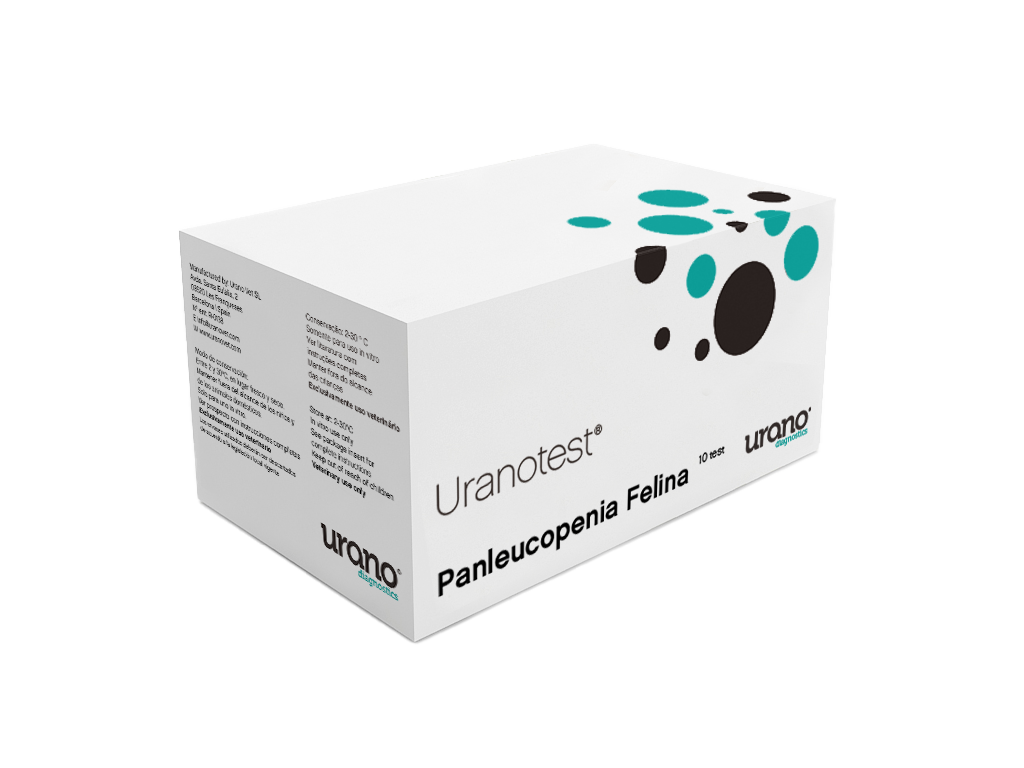
Diagnostic tests
Uranotest Feline Panleukopenia
Detection of Feline Panleukopenia antigen in cat faeces.
| Specs | |
|---|---|
| Purpose: | Detection of Feline panleukopenia antigen in cat faeces |
| Sample: | Faeces |
| Sensitivity: | 97% versus PCR |
| Specificity: | 98.5 % versus PCR |
| Reading time: | 5-10 minutes |
| Presentation: | Boxes with 1, 5 or 10 tests |
| Registration No: | 1717 RD |
Characteristics
- Early detection of virus in faeces, even before the appearance of symptomatology.
- Without crossed reactions with Coronavirus, FeLV, FIV, Calicivirus,Herpesvirus type I, Chlamydophilia felis.
- High specificity: the technique used is based on specific detection of the Feline panleukopenia virus, not on a crossed reaction with canine parvovirus.
- High sensitivity: detection limits at only 104,5TCID50/0,1 ml.
Information for the veterinarian
The Uranotest Feline Panleukopenia diagnostic kit is based on the immunochromatographic technique and is designed for the qualitative detection of Feline Panleukopenia virus in feline faeces.
The test consists of several overlapped membranes. On one of the membranes, there are a test line (T line) and control line (C line). The lines are not visible before applying the sample. After applying the sample in the appropriate sample well, migration begins by capillarity action through the membrane. If the result is negative, one purple colour band appears in the C area. This line, called control line, always appears, as it is a control line indicating that the test has successfully performed. If the test result is positive, in addition to the control line, a second line will form in the test area (Test line).
- Test devices individually packaged in aluminium pouch.
- Tubes with buffer solution for sample dilution.
- Swabs for sample collection.
- Disposable pipettes.
- Instructions for use.
- For veterinary use only.
- Wear disposable gloves when handling the samples. All samples should be treated as potentially infectious. Wash and disinfect hands after handling. Avoid aerosol formation when dispensing the sample.
- To obtain good results, it is important to add the correct sample volume.
- Open the device just before use.
- All reagents must be at room temperature before performing the test.
- Do not use the test if the envelope is damaged or broken.
- Do not re-use.
- Do not use reagents after the expiry date.
- The quality of each component of the kit has been individually assessed for each batch. Do not mix components or reagents from kits with different batch numbers.
DOCUMENTATION FOR THE VETERINARY
* This information is available only to veterinarians. Clicking the download link declares that possess appropriate qualifications to access the content..
Frequently Asked Questions
Detection of Feline Panleukopenia virus (FPV) antigen in cat faeces.
The symptoms are variable, depending on the virulence of the virus, the immune status of the host and the possible associated bacterial complications.
Basically, there are two clinical presentations. The classic presentation is associated with symptoms of gastroenteritis along with leukopenia, while the atypical presentation mainly affects newborns and has nervous symptomatology.
There is little data available regarding the prevalence of the illness. Although it has notably decreased thanks to vaccines, it is still very frequent in street cats or those coming from groups, and is one of the main causes of death for this collective.
Mortality is high, between 25 and 90%, with great variability depending on the precocity with which diagnosis and treatment are performed. As such, it is highly advisable to perform a test on any cat, especially if it is young, coming from at-risk populations, with symptoms compatible with the illness.
The Feline Panleukopenia Uranotest is highly sensitive and can detect very small antigen levels, so it is not advisable to use a large amount of faeces. To the contrary, if we use an excessive sample volume or if it has particles that are too thick, this may interfere in the migration process of the sample. If you have used an excessive sample volume, mix well, wait a minute for the thickest particles to sediment and take the sample from the supernatant.
The appropriate sample volume is described in the kit’s prospective.
Between 5 and 10 minutes, you can read with total reliability.
After that time, degradation and diffusion of the colours on the strip may occur. This does not always happen, but the recommendation is that the test should always be repeated if the reading was not taken before the indicated time, since this may lead to an erroneous interpretation.

